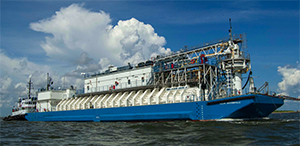This summer’s delivery of Clean Jacksonville, a liquefied natural gas (LNG) bunker barge built for TOTE Maritime by Conrad Industries, signals both companies’ increasing confidence in a wider industry move toward alternative fuels. The project is just one of several related efforts they’re making: TOTE is working to convert its entire fleet to dual-fuel propulsion, and Conrad has created a new business unit, Conrad LNG, to focus specifically on natural gas projects.
“We believe the continued development of the LNG fuel market to be of critical importance,” said Johnny Conrad, president and chief executive officer of Conrad Industries. “We want Conrad to be an active participant and a leader in the development of this market.”
Other maritime companies are heading in the same direction, including Quality Liquefied Natural Gas Transport (Q-LNG), which has contracted with Mississippi-based VT Halter Marine to build two offshore articulated tug-barges (ATBs) for LNG bunkering. The first, which can carry 4,000 cubic meters of LNG, will be chartered to Shell Oil to provide fuel to ports in Florida and the Caribbean. The second is being built on spec and will be able to carry twice as much fuel.
The move toward alternative fuels is being driven in part by economics, according to industry experts. The price per unit of energy is cheaper for natural gas than petroleum, and the long-term price stability is more predictable. But it’s also being driven by regulatory compliance changes.
In 2010, the International Maritime Organization (IMO) officially designated a 200-nautical-mile Emission Control Area around North America. It followed that by tightening fuel sulfur restrictions over the next few years, and set January 2020 as the implementation date for a significant reduction — to 0.5 percent — in maritime fuel sulfur worldwide.
LNG can eliminate sulfur oxide and particulate matter emissions, and reduce nitrogen oxide emissions by as much as 90 percent. Though just one LNG bunkering vessel had been built globally by 2017, that number had climbed to six by early 2018 and is expected to double by the time the new IMO cap takes effect.
Delivered in August, the 232-foot Clean Jacksonville is the first purpose-built LNG bunker barge constructed in North America. It was designed by Bristol Harbor Group Inc. for unmanned operation in inland waterways or near-coastal waters, with a transfer procedure similar to bunkering with traditional fuel. It can carry about 580,000 gallons of LNG in a single membrane-type tank.
Conrad worked with GTT, the company that developed the membrane system, to train its employees on construction and testing protocols. Brett Wolbrink, vice president of Conrad LNG, called the construction project “proud and humbling.” He cited the “collaborative regulatory efforts” of the U.S. Coast Guard and American Bureau of Shipping for making the first-of-a-kind build possible.
TOTE Maritime Puerto Rico will employ Clean Jacksonville to bunker two LNG containerships operating between Florida and San Juan. Tugboats will move the barge between the JAX LNG facility in Jacksonville and TOTE’s container terminal on the St. Johns River.
“TOTE has chosen LNG as its fuel of choice for the significant environmental benefits it provides to the communities we serve,” said Tim Nolan, president and CEO. “TOTE is committed to caring for the environment and strives to be an innovative leader in this area.”
In early 2018, TOTE Maritime Alaska began the conversion of its two Orca-class cargo ships, operated in the Pacific Northwest, to LNG. The company installed tanks and accompanying infrastructure behind the bridge of the 839-foot North Star, and made initial updates to the engine. All conversions are scheduled to be completed by early 2022.

